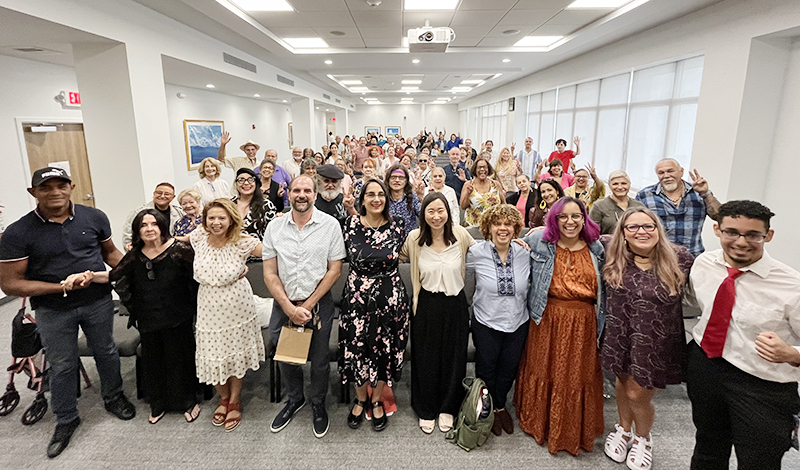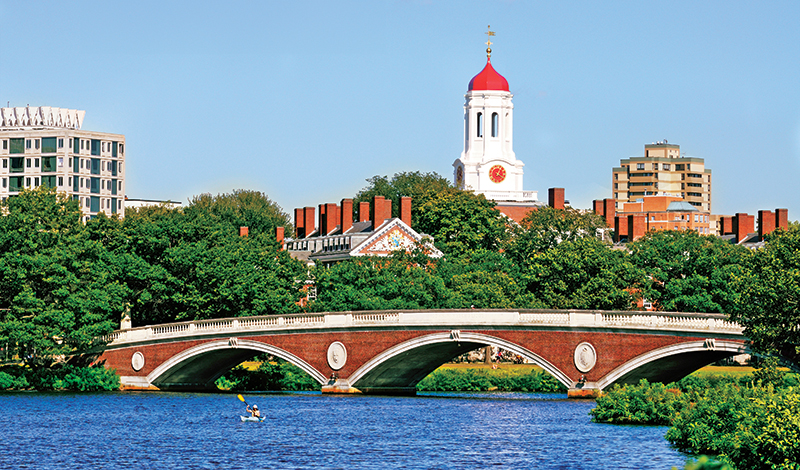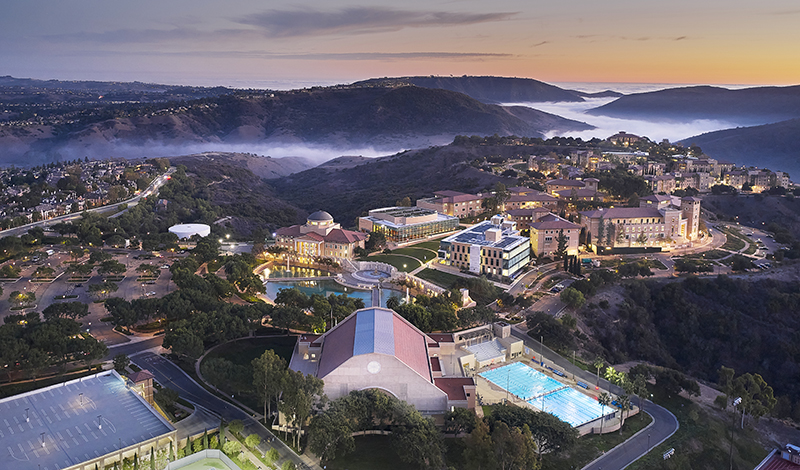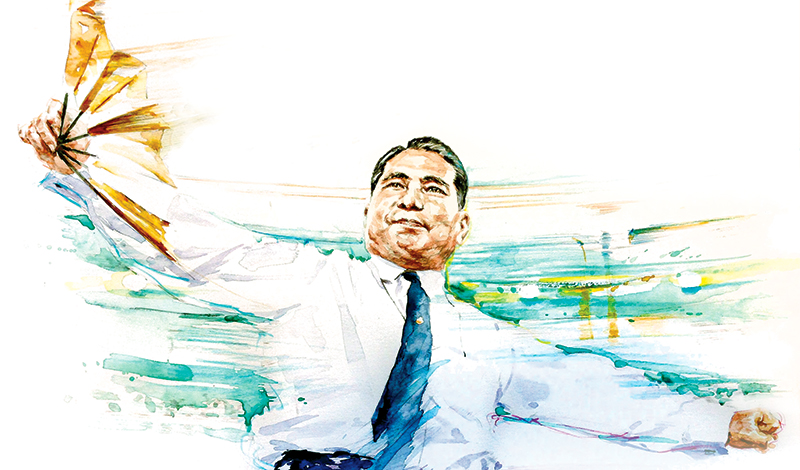This article, pp. 6–9, briefly recounting Ikeda Sensei’s life and contributions, was translated from the Nov. 19, 2023, issue of the Soka Gakkai’s daily newspaper, Seikyo Shimbun.
A Youth Dedicated to Protecting the Mentor and Spreading the Law
A solemn encounter between mentor and disciple opened the way for a lasting journey of kosen-rufu and peace. On Aug. 14, 1947, 19-year-old Daisaku Ikeda attended a Soka Gakkai discussion meeting led by then-General Director Josei Toda in Ota Ward, Tokyo. Moved by Mr. Toda’s conviction and character, the young Daisaku joined the Soka Gakkai 10 days later on Aug. 24. In August 1950, Mr. Toda’s businesses faced dire challenges amid the turmoil and confusion following World War II, and he announced he would resign as Soka Gakkai general director. While many members left his side, Sensei remained, expressing his own immovable commitment to his mentor in a poem:
Still serving
an old
and mystic bond—
though others change,
I alter not. [1]
“Even if many forget their debt of gratitude and betray their mentor, I will not change in the least”—because Sensei carried out a fierce struggle to dedicate his life to the Law as a genuine disciple, mentor and disciple won over their difficult situation.
Mr. Toda overcame his business challenges, and on May 3, 1951, he was inaugurated as the second Soka Gakkai president. Mr. Toda vowed to expand the Soka Gakkai membership to 750,000 households, marking the start of the Soka Gakkai’s fresh and dynamic growth. The membership at the time numbered 3,000. Most thought that Mr. Toda’s goal was no more than a pipe dream. But Ikeda Sensei burned with the determination to realize his mentor’s vision, and he personally engaged in propagation, marking the first step toward accomplishing 750,000 households.
“As long as there is … even a single true disciple” Sensei declared, “we will achieve kosen-rufu.”[2]
“When I was a youth, I fought and fought. I protected Mr. Toda and continued to protect the Soka Gakkai. This is the true way of mentor and disciple,” Sensei wrote. “The three founding presidents, mentors and disciples of Soka, laid down their lives, fought and won. There is no honor apart from the path of mentor and disciple” (tentative translation).

The Bodhisattvas of the Earth Expand to 192 Countries and Territories
Just before he passed away, second Soka Gakkai President Josei Toda said to his young disciple Daisaku Ikeda:
I want to go—to travel the world on a journey for kosen-rufu. … The world is your challenge; it is your true stage.[3]
On Oct. 2, 1960, Ikeda Sensei departed Tokyo’s Haneda Airport to take the first step in his travels for peace, to realize the dream of worldwide kosen-rufu entrusted to him by his mentor.
Sensei visited nine cities in the U.S., Canada and Brazil over 24 days. Pouring his entire being into encouraging each person he met, he established two chapters and 17 districts.
Reflecting on that first trip, Sensei writes:
Shin’ichi[4] would gladly go to the ends of the earth, no effort too great or demanding, if it were to visit and encourage even one fellow member.
Shin’ichi was confident that, just as a river grows from one small spring, a mighty river for peace could grow from each such individual.[5]
On Jan. 26, 1975, at the founding of the Soka Gakkai International, Sensei called on participants:
Rather than seeking after your own praise or glory, I hope that you will dedicate your noble lives to sowing the seeds of peace of the Mystic Law throughout the entire world. I shall do the same.[6]
Traveling to 54 countries and territories over the course of his life, Sensei led a great people’s movement for peace, culture and education based on the Buddhist tenet of respect for the dignity of life. The Soka Gakkai’s global network has expanded to 192 countries and territories, with membership outside of Japan numbering 3 million. We are in an era when the sound of people chanting Nam-myoho-renge-kyo envelops the Earth.
Sensei began writing the novel The Human Revolution on Dec. 2, 1964, with the resolve to correctly convey the truth of his mentor President Toda to future generations. On Aug. 6, 1993, he began drafting the sequel, The New Human Revolution, which he completed on the same date in 2018.
For over half a century, Sensei recorded the true account of the mentors and disciples of Soka, and, with the power of the pen, he continued to encourage members around the world.

Dialogues on Humanism and Actions for Peace
“I’ll do it!” [Shin’ichi Yamamoto] decided. “I’ll give my all to launching a great wave of dialogue around the globe for the sake of peace. I must bring the world together through the philosophy of Buddhist humanism.” [7]
Since his inauguration as third Soka Gakkai president, Ikeda Sensei traveled the globe fostering an alliance of good citizens who desire peace.
He writes, “The power of dialogue is a force for peace that creates a new age.”[8]
With this conviction, Sensei spoke with world leaders, scholars and cultural figures, including historian Arnold J. Toynbee, Chinese Premier Zhou Enlai, President Mikhail Gorbachev of the Soviet Union and President Nelson Mandela of South Africa.
For the sake of posterity, 80 of Sensei’s dialogues with leading figures have been published. He also gave 32 lectures at universities and academic institutions around the world, including Harvard and Columbia.
As a private citizen, Sensei built bridges of peace throughout Asia and the entire world. In 1968, he made a dynamic call for the earliest possible normalization of Japan-China relations. In 1974 and 1975, amid the Cold War, Sensei visited China, the Soviet Union and the United States in succession, speaking with leaders of each country to resolve tensions.
Since Jan. 26, 1983, SGI Day, Sensei presented 40 annual peace proposals, carrying on the spirit of his mentor second Soka Gakkai President Josei Toda’s Declaration for the Abolition of Nuclear Weapons.
In his proposals, Sensei consistently supported the activities of the United Nations, which he referred to as the “parliament of humankind,” continuing to transmit a philosophy of hope toward abolishing nuclear weapons, ending international conflict and preventing a climate crisis.
Moreover, Sensei bolstered peace-building efforts within academia. He established the Toda Peace Institute; the Institute of Oriental Philosophy in Japan; the Ikeda Center for Peace, Learning, and Dialogue in the United States; and the Soka Amazon Institute in Brazil.
His mentor, Mr. Toda, resolved to eliminate the word misery from the planet. Sensei inherited the flame of this pledge and has now passed it on to his disciples around the world.

Establishing a Foundation for Education and Culture Worldwide
Ikeda Sensei declared that his final major focus would be in the field of education. His steadfast conviction was that the only way to build a peaceful society is to nurture youth who will shoulder the future.
The Soka Gakkai was founded on Nov. 18, 1930, by educators Tsunesaburo Makiguchi and Josei Toda, who initially named it Soka Kyoiku Gakkai (Value-Creating Education Society). Both Mr. Makiguchi and Mr. Toda wished to one day establish a Soka education institution. And it was Ikeda Sensei who realized this long-cherished wish.
In 1968, Soka Junior High and High Schools opened in Kodaira, Tokyo. On April 2, 1971, Soka University opened in Hachioji, Tokyo. The year marked 100 years since Mr. Makiguchi’s birth while April 2 is the anniversary of Mr. Toda’s passing.
In 1973, Soka Girls Junior High and High School (currently Kansai Soka Junior High and High School) opened in Katano, Osaka. Following this, Sensei established one school after another—Sapporo Soka Kindergarten, Tokyo Soka Elementary, Kansai Soka Elementary and Soka Women’s College. In 2001, Soka University of America opened its doors in Aliso Viejo, California. Soka kindergartens also opened in Hong Kong, Singapore, Malaysia and the Republic of Korea. And Brazil Soka Schools run from kindergarten through high school. In August 2023, the newly opened Soka International School Malaysia welcomed its first class.
Global citizens dedicated to working for the happiness of all humanity will continue to emerge from these Soka educational institutions.
Sensei also exerted himself in promoting cultural development and exchange. His motivation is expressed in his words “Only culture is a force strong enough to put an end to conflict and lead humanity in the direction of peace.”[9]
In 1963, Sensei established the Min-On Concert Association (Min-On), and, in 1983, he founded the Tokyo Fuji Art Museum. Min-On has carried out cultural exchanges with 112 countries and territories, with audiences totaling 120 million. The Tokyo Fuji Art Museum houses 30,000 artworks and has held 50 cultural exchange exhibits around the world.
These institutions and their initiatives have opened avenues for humanity to share the treasures of great musical and artistic beauty, connecting people’s hearts the world over.
December 8, 2023, World Tribune, pp. 6–9
References
- The New Human Revolution, vol. 30, p. 79. ↩︎
- Ibid., p. 825. ↩︎
- The Human Revolution, p. 1901. ↩︎
- Shin’ichi Yamamoto: Ikeda Sensei’s pseudonym in the novel The New Human Revolution. ↩︎
- March 20, 1998, World Tribune, p. 13. ↩︎
- The New Human Revolution, vol. 21, p. 33. ↩︎
- The New Human Revolution, vol. 16, p. 173. ↩︎
- NHR-30, 114. ↩︎
- Discussions on Youth, p. 177. ↩︎
You are reading {{ meterCount }} of {{ meterMax }} free premium articles

